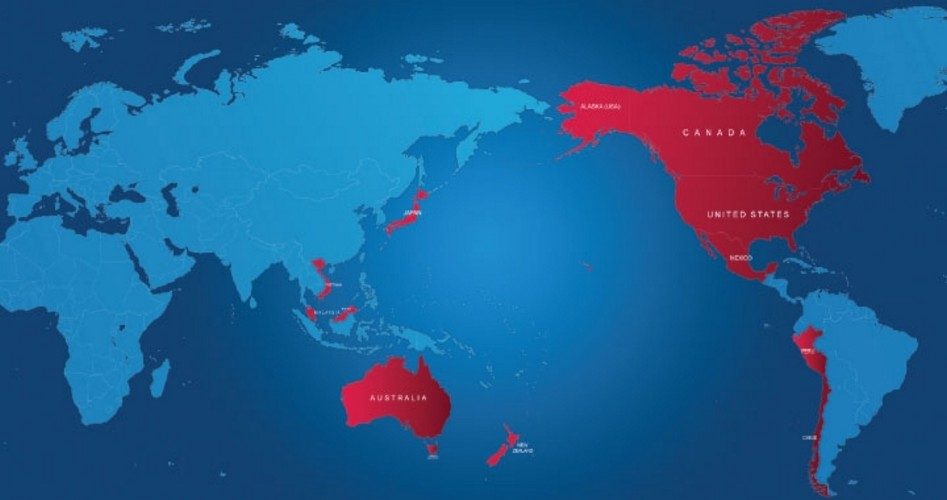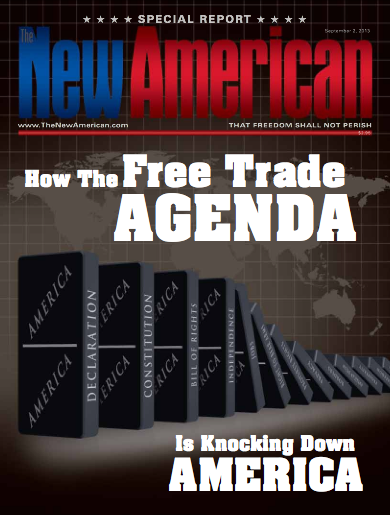
With little fanfare or public notice, the Obama administration has pushed full speed ahead over the past year with negotiations on the Trans-Pacific Partnership (TPP), a so-called free trade agreement loaded with potential for enormous political and economic harm for Americans. The TPP, which currently involves 12 nations — Australia, Brunei, Canada, Chile, Malaysia, Mexico, New Zealand, Peru, Singapore, the United States, and Vietnam (Japan is negotiating for membership and is likely to join soon) — is really intended as an interim arrangement, on the road to an expanded Free Trade Area of the Asia Pacific (FTAAP) that would include all 21 nations of the grouping known as the Asia-Pacific Economic Cooperation (APEC). That includes China and Russia.
The architects and promoters of the TPP and FTAAP frequently point with admiration to the “integration” process of the European Union (EU) as the model they would like to see implemented for the Asia-Pacific rim nations. As with the Transatlantic Trade and Investment Partnership (TTIP), the Trans-Pacific Partnership has been designed to follow the EU example of relentless widening and deepening, constantly eroding national sovereignty, while building “transnational governance” that is not restrained by the checks and balances of national constitutions.
Secrecy vs. Transparency
If there is one word that is used more often than “reform” by governments, politicians, and international organizations — and abused even more frequently and egregiously — it is “transparency.” As with the United Nations and the World Trade Organization (WTO), the White House and the U.S. Trade Representative’s (USTR) office regularly proclaim their commitment to transparency while doing everything possible to hide their actions from their constituents. The USTR’s “Fact Sheet: Transparency and the Trans-Pacific Partnership” is intended to give the impression that the Obama administration is forthrightly providing the American people with all the up-to-date information they need to accurately evaluate the agreements that are being made in their name, and that would, if accepted by Congress, devastatingly impact their lives, their liberty, and their future.
The USTR “Fact Sheet” cites as evidence of its transparency efforts the number of consultations it has held with its selected trade advisory committees and privileged “Civil Society stakeholders.” It states, for instance:
Over the course of the TPP negotiations, USTR has conducted more than 147 meetings with the trade advisory committees. Since June 11, 2010, USTR has posted 110 TPP documents to a website for cleared trade advisors to review and provide comments.
This transparency boast actually exposes a dangerous feature of the TPP process: The TPP documents are not available to the average American citizen, only to “cleared trade advisors.” And who are the “cleared trade advisors”? According to the USTR, these are “representatives from industry, agriculture, services, labor, state and local governments, and public interest groups.” But, apparently, that does not include elected representatives of the American people, since members of Congress have been forced to plead, and threaten in order to get a peep at the secret TPP texts.
For instance, Senator Ron Wyden (D-Ore.), the chairman of the Senate Finance Committee’s subcommittee on International Trade, Customs, and Global Competitiveness, requested copies of the TPP draft documents but was stonewalled by the USTR. When Senator Wyden threatened to propose a measure in the Senate that would force transparency on the process, the USTR agreed to grant the senator a peek at the documents, though his staff was not permitted to see them. This type of secretive process has no legitimate place in our system of government, and it obviously puts Congress at a distinct disadvantage in the TPP process, since the real work of examining the detailed legal texts normally falls to congressional staff members who are often experts in particular areas of domestic and foreign policy.
Wyden spokeswoman Jennifer Hoelzer told the online Huffington Post that it was also “insulting” that members of Congress and their staff are denied access to documents that industry officials on the “cleared” trade advisory committees are given free access to. “I would point out how insulting it is for them to argue that members of Congress are to personally go over to USTR to view the trade documents,” Hoelzer said. But they are not allowed to make copies. However, Hoelzer pointed out, “An advisor at Halliburton or the MPAA [Motion Picture Association of America] is given a password that allows him or her to go on the USTR website and view the TPP agreement anytime he or she wants.”
The USTR has responded to mounting criticism over its “transparency deficit” with a PR campaign that has featured a succession of meetings and consultations with “stakeholders” that are substantively meaningless but give the appearance of democratic legitimacy. The USTR transparency fact sheet states:
USTR invited over 250 Civil Society stakeholders to a briefing held on June 19, 2012 and provided non-governmental organizations the opportunity to discuss specific issues with USTR negotiators.
Moreover, it says:
USTR will continue to engage with stakeholders to find ways to increase transparency in the TPP negotiations, while moving ahead toward an innovative, groundbreaking 21st-century trade agreement that will support more jobs for working Americans here at home.
The Controlled Opposition
The Obama administration’s standard response to any question or objection is to replay the all-purpose, shop-worn mantra that it — and the Bush and Clinton administrations before it — monotonously, mindlessly intones: “More trade equals more jobs and more prosperity…. More trade equals more jobs and more prosperity.” End of discussion, end of debate.
And when pressed into a corner, the TPP advocates will “engage” and “brief” a pre-selected coterie of activist stakeholders who constitute the usual controlled opposition. According to the USTR, these stakeholders are “leaders from the AFL-CIO, Citizens Trade Campaign, Coalition for a Prosperous America, the Emergency Committee for American Trade, Friends of the Earth, Grocery Manufacturers Association, Maine Citizens Trade Policy Commission, Public Citizen, and the Sierra Club — among others.”
This is the same lineup of “Civil Society Organizations” (CSOs) that is providing faux grassroots participation for the TTIP planned economic and political merger of the United States with the EU (see our article “EU/U.S. — Transatlantic Convergence“). No surprise there; we have seen the same CSO/NGO players engaged in the same deceptive games during the battles over the North American Free Trade Agreement (NAFTA), the Central American Free Trade Agreement (CAFTA), the Free Trade Area of the Americas (FTAA), the Security and Prosperity Partnership (SPP), the World Trade Organization (WTO), and the many other trade-agreement fights. The purpose of these sham opposition groups is to foster the false perception of widespread public involvement in the TPP process and strong public consensus for the TPP objectives. Even when these “opposition” groups publicly object to truly objectionable features of these trade agreements, it is usually for the wrong reasons, and invariably they argue that the proposed new trade authority be given more powers and go beyond trade issues to deal with the environment, labor, financial services, etc. By establishing themselves as the noisiest adversaries, and the only ones the establishment politicians and media deem credible, they successfully co-opt the opposition label and prevent any genuine opponents from rising to the fore. Then they can be counted on to fold, sell out, or walk out at the critical moment and leave the field wide open for passage of the agreement. Not surprisingly, virtually all of these ostensibly grassroots organizations are actually astro-turf groups funded by grants from government agencies, the big tax-exempt foundations, major corporations, and big labor unions.
The TPP proponents are only too happy to accommodate this fake vox populi; as with the TTIP, they are including virtually everything — including the kitchen sink — in the Trans-Pacific Partnership. The White House, the USTR, the State Department, and the private organizations promoting the TPP openly admit that this agreement is not simply a trade agreement, not simply about lowering tariffs. It encompasses — among other things — customs, telecommunications, investment services, technical barriers to trade, sanitary and phytosanitary measures, intellectual property, regulatory coherence, development, non-conforming measures and cross-border trade in services, rules of origin, competition, agriculture, textiles, and environment. Each of these “deepening” areas is pregnant with incredible potential for havoc.
What Are They Hiding?
As just one example of the enormous dangers that are lurking in the hundreds (or thousands) of pages of still-secret texts, consider the leaked TPP draft text on intellectual property that would threaten Internet freedom — as well as American sovereignty — with new TPP surveillance requirements. As The New American reported last year, the leaked document would mandate that TPP member nations enact regulations that require Internet service providers (ISPs) to privately enforce copyright protection laws. “Current U.S. law,” noted The New American’s Joe Wolverton, “specifically the Digital Millennium Copyright Act (DMCA), would be supplanted by TPP Article 16.3. This provision in the TPP draft document paves the way for a new copyright enforcement scheme that extends far beyond the limits currently imposed by DMCA.”
The Electronic Frontier Foundation pointed out the TPP threat to Internet freedom:
Private ISP enforcement of copyright poses a serious threat to free speech on the Internet, because it makes offering open platforms for user-generated content economically untenable. For example, on an ad-supported site, the costs of reviewing each post will generally exceed the pennies of revenue one might get from ads. Even obvious fair uses could become too risky to host, leading to an Internet with only cautious and conservative content.
The net effect would be to squeeze out the smaller, independent ISPs, further cartelizing our communications and news media, and eventually wiping out the burgeoning alternative Internet-based news media.
Another TPP draft document leaked last year would require the United States to agree to exempt foreign corporations from our laws and regulations. Foreign businesses could challenge any of our federal, state, or local laws and regulations as being unfair practices in restraint of trade. Who would adjudicate these types of cases? They would be decided by an international arbitration tribunal overseen by the secretary-general of the United Nations.
This is an all-out assault on national sovereignty, unconstitutionally transferring legislative powers from the U.S. Congress; state legislatures; and local, city, and county governments to unaccountable international bureaucrats, and judicial powers from our federal and state courts to black-robed TPP globalists. It would also confer huge advantages on foreign businesses and large multinationals, while concomitantly putting American businesses — especially small and medium-sized enterprises — at a competitive disadvantage. American businesses would remain shackled with the onerous regulatory burden of EPA, FDA, ADA, OSHA, etc., while their foreign competitors could operate here unimpeded by those same strictures.
How many more similar dangers (or worse) are hidden in the TPP texts? Based on what has already been leaked so far, should Congress not already be demanding total transparency, with full and immediate access to all of the TPP negotiation texts?
At the 12th round of TPP negotiations, held in Dallas, Texas, in May of 2012, stakeholder participants requested that the negotiation texts be made public so that stakeholders could formulate more informed evaluations, questions, and responses. How Barbara Weisel, assistant U.S. trade representative for Southeast Asia and the Pacific and the lead negotiator for the United States at TPP, replied to this reasonable request is chillingly instructive. According to the USTR’s own website, “Weisel said that while the U.S. position is that constantly evolving TPP chapter texts cannot be released to the public, the Office of the U.S. Trade Representative has been and remains committed to discussing in-depth with a wide range of stakeholders the formation of U.S. positions, the substance of negotiations as they take place, and how issues should be handled by negotiators as talks continue.”
The “TPP chapter texts cannot be released to the public”! That’s the Obama administration’s “transparency”!
From TPP to FTAAP
We mentioned at the beginning of this article that the TPP is actually intended as a door opener to an even larger and more ambitious Free Trade Area of the Asia Pacific (FTAAP). That is not merely the conjecture of this writer; U.S. officials and the original architects of the TPP have stated this explicitly.
A very important source of statements in this regard is the pro-TPP book published in January of this year by the Peter G. Peterson Institute for International Economics (PIIE), entitled Understanding the Trans-Pacific Partnership, coauthored by Jeffrey J. Schott, Barbara Kotschwar, and Julia Muir. The PIIE is one of the premier global think tanks and has played an especially important role in promoting the WTO, IMF, United Nations, and free trade agreements (FTAs), including NAFTA, CAFTA, TPP, and FTAAP. Schott, the primary author of the study, has been in the forefront of the establishment wonks designing and promoting FTAs. The PIIE study states (in Chapter 1):
Over time, the TPP is expected to evolve into a major integration arrangement covering most of the members of the Asia-Pacific Economic Cooperation (APEC) forum.
Again in Chapter 1, we find:
The TPP is regarded as an interim arrangement or stepping stone toward a broader, regionwide Free Trade Area of the Asia Pacific (FTAAP), possibly within a decade, as envisaged by APEC leaders in Bogor [Indonesia] in November 1994 and reaffirmed more recently by them in their meeting in Honolulu in November 2011. TPP negotiators are not only thinking about new countries joining the ongoing talks but also planning and constructing the trade pact with a view toward future linkages with other APEC members, including and especially China.
Chapter 6 of the PIIE book is revealingly entitled “Moving from TPP to FTAAP.” It declares:
The current TPP architects envision building an eventual FTAAP on the comprehensive foundations of the TPP accord, with other APEC countries joining the pact in coming years.
Perhaps the most important admissions in Understanding the Trans-Pacific Partnership are to be found in the book’s preface by PIIE’s director, C. Fred Bergsten. As much as anyone, Dr. Bergsten shepherded APEC and TPP into existence. “Twenty years ago,” Bergsten writes in the preface, “I chaired the Eminent Persons Group (EPG) established by the leaders of the Asia Pacific Economic Cooperation (APEC) forum to develop a long-term vision for economic integration of the region.”
Bergsten then goes on to note that “the seeds of a Free Trade Area of the Asia Pacific (FTAAP) began to take serious root about a decade ago, with proposals from APEC’s Business Advisory Council, and now have multiple green shoots — the biggest and sturdiest of which is the ongoing negotiation of the Trans-Pacific Partnership (TPP).”
Those familiar with Dr. Bergsten’s background and connections recognize that these admissions are all the more important because he, Schott, and the other PIIE authors are channeling the party line of the Council on Foreign Relations (CFR) and the Trilateral Commission (TC), two of the most influential globalist organizations pushing for a New World Order that envisions a global monetary authority and a world government under the United Nations. Bergsten is a longtime member and leading intellectual of both the CFR and TC. The PIIE is named for and chaired by Peter G. Peterson, a longtime chairman of the CFR. The PIIE board of directors and advisory board, as well as its roster of scholars and fellows, is a register of prominent CFR and TC members, including David Rockefeller, former chairman of the CFR and founder of the TC. Many of the PIIE’s leaders have held Cabinet positions in various administrations. Leading the Obama TPP/FTAAP effort are CFR/TC members Michael Froman (U.S. trade representative) and Robert Hormats (undersecretary of state).
During the George W. Bush administration, U.S. Trade Representative Susan Schwab (CFR) praised APEC at the organization’s 2007 meeting in Cairns, Australia, and endorsed the FTAAP.
“FTAAP is a visionary proposal that APEC is well-suited to take on,” said Amb. Schwab. “By more effectively knitting together the dynamic economies of the region, an FTAAP would some day yield enormous social and commercial benefits for the people of the Asia-Pacific region, including the United States.”
The dangers of the TPP are becoming daily more obvious. The secrecy of the TPP negotiation process and the threats to national sovereignty that have already been exposed due to leaks of text drafts show it to be incompatible with our American constitutional system. The fact that its authors and promoters admit the TPP is just a “steppingstone” to an even more expansive and more dangerous FTAAP, should be sufficient to guarantee its defeat. However, defeating the TPP and FTAAP will require a coordinated, sustained effort by American patriots over the next few months to take this information to their fellow citizens. It will take — in the words of Samuel Adams — “an irate, tireless minority keen to set brush fires in people’s minds.” And then the heat and light from those brushfires must be directed at members of Congress so that they will honor their constitutional duty to stop the TPP.
 The above article is part of our special report “How the Free Trade Agenda Is Knocking Down America.” This report warns that the free trade agenda is a dangerous and deceptive bait and switch. The intent is not to create genuine free trade but to transfer economic and political power to regional arrangements on the road to global governance. Because of what is at stake, we encourage you to read the entire special report (click here for the PDF) and to become involved.
The above article is part of our special report “How the Free Trade Agenda Is Knocking Down America.” This report warns that the free trade agenda is a dangerous and deceptive bait and switch. The intent is not to create genuine free trade but to transfer economic and political power to regional arrangements on the road to global governance. Because of what is at stake, we encourage you to read the entire special report (click here for the PDF) and to become involved.


